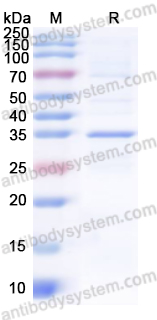Catalog No.
YVV40401
Expression system
E. coli
Species
Epstein-Barr virus (strain B95-8) (HHV-4) (Human herpesvirus 4)
Protein length
Leu175-Phe245
Predicted molecular weight
36.56 kDa
Nature
Recombinant
Endotoxin level
Please contact with the lab for this information.
Purity
>90% as determined by SDS-PAGE.
Accession
P03206
Applications
ELISA, Immunogen, SDS-PAGE, WB, Bioactivity testing in progress
Form
Lyophilized
Storage buffer
Lyophilized from a solution in PBS pH 7.4, 1mM EDTA, 4% Trehalose, 1% Mannitol.
Reconstitution
Reconstitute in sterile water for a stock solution.
Shipping
In general, proteins are provided as lyophilized powder/frozen liquid. They are shipped out with dry ice/blue ice unless customers require otherwise.
Stability and Storage
Use a manual defrost freezer and avoid repeated freeze thaw cycles. Store at 2 to 8°C for frequent use. Store at -20 to -80°C for twelve months from the date of receipt.
Alternative Names
Lytic switch protein BZLF1, EB1, Protein Z, Trans-activator protein BZLF1, Zta, bZIP transcription factor ZEBRA, BZLF1
Dihydrotestosterone-androgen receptor signaling suppresses EBV-positive gastric cancer through DNA demethylation-mediated viral reactivation., PMID:40504439
Inhibitory effect of recombinant BCG containing the fusion gene BFNA on EB virus-positive tumors., PMID:40459582
Anti-EBV: Artificial intelligence driven predictive modeling for repurposing drugs as potential antivirals against Epstein-Barr virus., PMID:40458637
EBV Reactivation-associated gene signature predicts poor prognosis in nasopharyngeal carcinoma., PMID:40457434
Hsa-miR-7974 Suppresses Epstein-Barr Virus Reactivation by Directly Targeting BZLF1 and BRLF1., PMID:40431607
Leveraging the interconnected unfolded protein response and NLRP3 inflammasome pathways to reactivate Epstein-Barr virus in diffuse large B-cell lymphomas., PMID:40330549
Influence of DNA Sequences on the Thermodynamic and Structural Stability of the ZTA Transcription Factor─DNA Complex: An All-Atom Molecular Dynamics Study., PMID:40266646
Heat shock factor 2 regulates oncogenic gamma-herpesvirus gene expression by remodeling the chromatin at the ORF50 and BZLF1 promoter., PMID:40245053
A Comparative Genomic Analysis of Epstein-Barr Virus Strains with a Focus on EBV2 Variability., PMID:40141350
Epstein-Barr virus hijacks histone demethylase machinery to drive epithelial malignancy progression through KDM5B upregulation., PMID:40059116
Interpreting the role of epigallocatechin-3-gallate in Epstein-Barr virus infection-mediated neuronal diseases., PMID:39849283
In-depth analysis of serum antibodies against Epstein-Barr virus lifecycle proteins, and EBNA1, ANO2, GlialCAM and CRYAB peptides in patients with multiple sclerosis., PMID:39742283
Computational biology assisted exploration of phytochemicals derived natural inhibitors to block BZLF1 gene activation of Epstein-Bar virus in host., PMID:39738195
Entry into the lytic cycle exposes EBV-infected cells to NK cell killing via upregulation of the MICB ligand for NKG2D and activation of the CD56bright and NKG2A+KIR+CD56dim subsets., PMID:39676862
Ubiquitin-Mediated Effects on Oncogenesis during EBV and KSHV Infection., PMID:39459858
Reactivation of Epstein-Barr virus by n-butyric acid from Pseudoramibacter alactolyticus induces inflammatory cytokines in periapical granulomas., PMID:39401546
TianTan vaccinia virus-based EBV vaccines targeting both latent and lytic antigens elicits potent immunity against lethal EBV challenge in humanized mice., PMID:39387189
Epstein-Barr virus replication within differentiated epithelia requires pRb sequestration of activator E2F transcription factors., PMID:39291960
Gene profiling of Epstein-Barr Virus and human endogenous retrovirus in peripheral blood mononuclear cells of SLE patients: immune response implications., PMID:39215087
Multiplex assays reveal anti-EBV antibody profile and its implication in detection and diagnosis of nasopharyngeal carcinoma., PMID:38894502
Evaluation of novel Epstein-Barr virus-derived antigen formulations for monitoring virus-specific T cells in pediatric patients with infectious mononucleosis., PMID:38877590
The nucleic acid binding protein SFPQ represses EBV lytic reactivation by promoting histone H1 expression., PMID:38755141
Lytic and Latent Genetic Diversity of the Epstein-Barr Virus Reveals Raji-Related Variants from Southeastern Brazil Associated with Recombination Markers., PMID:38732219
Synthetic BZLF1-targeted transcriptional activator for efficient lytic induction therapy against EBV-associated epithelial cancers., PMID:38702330
Differential carbonic anhydrase activities control EBV-induced B-cell transformation and lytic cycle reactivation., PMID:38530845
Ceramide promotes lytic reactivation of Epstein-Barr virus in gastric carcinoma., PMID:38197630
Construction of rBCG carrying the IL-2-BZLF1 fusion gene and its immunological function., PMID:38170315
A distinct isoform of lymphoid enhancer binding factor 1 (LEF1) epigenetically restricts EBV reactivation to maintain viral latency., PMID:38113273
A library-derived peptide inhibitor of the BZLF1 transcription factor., PMID:38041527
Upregulation of IQGAP2 by EBV transactivator Rta and its influence on EBV life cycle., PMID:37504571
Changes in SUMO-modified proteins in Epstein-Barr virus infection identifies reciprocal regulation of TRIM24/28/33 complexes and the lytic switch BZLF1., PMID:37410772
Evaluation of host cellular responses to Epstein-Barr virus (EBV) in adult lung transplant patients with EBV-associated diseases., PMID:37185866
Epstein‒Barr virus and human herpesvirus 6 infection in patients with systemic lupus erythematosus., PMID:36782252
Epstein-Barr Virus Synergizes with BRD7 to Conquer c-Myc-Mediated Viral Latency Maintenance via Chromatin Remodeling., PMID:36728436
HLA-E-restricted immune responses are crucial for the control of EBV infections and the prevention of PTLD., PMID:36477802
EBV infection mediated BDNF expression is associated with bladder inflammation in interstitial cystitis/bladder pain syndrome with Hunner's lesion., PMID:36441149
An in-silico insight into the predictive interaction of Apolipoprotein-E with Epstein-Barr virus proteins and their probable role in mediating Alzheimer's disease., PMID:36307908
Rta is the principal activator of Epstein-Barr virus epithelial lytic transcription., PMID:36174106
MC180295 Inhibited Epstein-Barr Virus-Associated Gastric Carcinoma Cell Growth by Suppressing DNA Repair and the Cell Cycle., PMID:36142506
High Predictive Value of the Soluble ZEBRA Antigen (Epstein-Barr Virus Trans-Activator Zta) in Transplant Patients with PTLD., PMID:36015048
Rapid antibody responses to Epstein-Barr virus correlate with reduced severity of primary infection., PMID:36007460
IFI16 Partners with KAP1 to Maintain Epstein-Barr Virus Latency., PMID:35969079
Andrographolide Inhibits Epstein-Barr Virus Lytic Reactivation in EBV-Positive Cancer Cell Lines through the Modulation of Epigenetic-Related Proteins., PMID:35889536
Maintenance of Epstein-Barr virus latency through interaction of LMP2A with CXCR4., PMID:35752684
LMP1 Induces p53 Protein Expression via the H19/miR-675-5p Axis., PMID:35674441
Estrogen induces the expression of EBV lytic protein ZEBRA, a marker of poor prognosis in nasopharyngeal carcinoma., PMID:35633182
Reduced IRF4 expression promotes lytic phenotype in Type 2 EBV-infected B cells., PMID:35472072
Epstein-Barr virus infection patterns in nodular lymphocyte-predominant Hodgkin lymphoma., PMID:35322462
Molecular Basis of Epstein-Barr Virus Latency Establishment and Lytic Reactivation., PMID:34960613
The danger molecule HMGB1 cooperates with the NLRP3 inflammasome to sustain expression of the EBV lytic switch protein in Burkitt lymphoma cells., PMID:34922257

